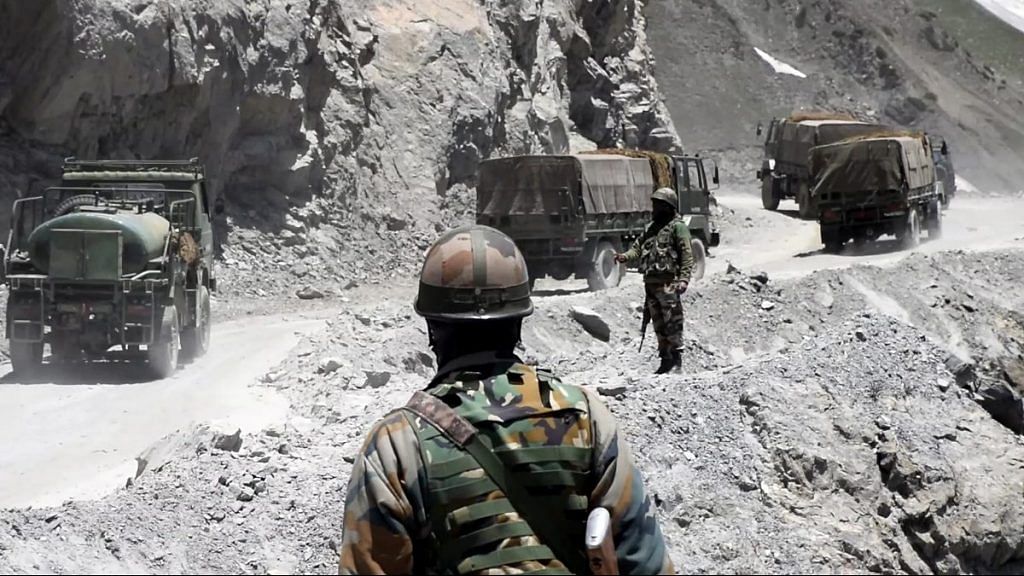New Delhi: The Army is being cautious about the disengagement with China in Ladakh as it feels Beijing could drag the whole process through the winter and use the distraction to make mischief elsewhere, possibly in the Northeast, ThePrint has learnt.
This probable scenario is high on the mind of military and security planners in New Delhi as well as those of the Northern and the Eastern commands, sources said.
China, the sources added, appears to be “intentionally dragging” the disengagement dialogue.
“China has built up (troops) in large numbers. We, too, have brought in a large number of troops into the Ladakh sector. The talks are very protracted and it seems China is intentionally dragging them,” a source said.
A second source added that “the fear is that, while China will force us to stay engaged in Ladakh, it might do something in another sector, possibly along Arunachal Pradesh”. “This could be coupled with pressure along the Line of Control by Pakistan,” the second source said.
The 1962 war, the sources added, is the biggest lesson in this regard, as the Chinese had then used deception and smokescreen to mount a full-frontal attack on India at multiple locations. Even so, one section in the security establishment believes China can no longer catch India by surprise since it has strengthened its defences on the border.
Also Read: Rifles, missiles, ammunition, drones — armed forces on shopping spree amid LAC tensions
‘They may come back later’
The Indian military has already beefed up its presence along the Line of Actual Control (LAC), in the northern (Ladakh), central (Uttarakhand, Himachal Pradesh) and eastern (Sikkim, Arunachal Pradesh) sectors.
The military’s apprehensions about the disengagement process, which seeks to resolve tensions triggered by Chinese incursions since May, were also brought to light by none other than Defence Minister Rajnath Singh during his visit to Ladakh last week.
He said the ongoing talks between the countries should resolve the situation, but he could not “guarantee” to what extent there would be a resolution.
The second source said even though the disengagement process is on, “nothing stops the Chinese from coming back later”. “One never knows what is running in someone’s mind. Hence, the policy for disengagement is trust but verify,” the source added.
However, a third source said China would not be able to catch India off-guard now since the Army has already taken steps all along the LAC to ensure that Beijing is not able to do come in like it did in Ladakh.
“China no longer enjoys the surprise factor. They had the first-mover advantage in Ladakh initially but they have been countered there and everywhere now,” the source added.
Also Read: Here’s how Army is getting 30,000 additional troops winter-ready in Ladakh
The history factor
The 1962 experience lies at the heart of the apprehensions about Chinese intentions. In the war that took place that year, sources said, the Chinese had used deception.
They transgressed at multiple places in Ladakh much prior to the actual beginning of the war on 20 October and their foray into the erstwhile North East Frontier Agency (NEFA, now Arunachal Pradesh).
Even in NEFA, it was not a direct attack. “The Chinese had first lit the fuse on 8 September 1962 by intruding into the Thagla Ridge area but this was not treated as a prelude to a full-scale invasion. It was dismissed as yet another minor border incident which could be ‘localised and dealt with firmly’,” Late Brig J.P. Dalvi noted in his book Himalayan Blunder.
Asked if they feared a repetition by the Chinese, a source said measures have been taken along the entire LAC to counter any Chinese move.
The Army is already basing its preparations at the LAC on the estimate that the disengagement process will continue through Ladakh’s long, icy winter. It has consequently been on a massive drive to ensure adequate supply of the right gear and adequate rations for the 30,000 additional troops deployed in multiple places along the LAC.
The Army has also been on a shopping spree to ensure that they don’t face any shortage of firepower or surveillance capability, among other things, in case the situation takes a turn for the worse.
Also Read: Modi’s bid to sway China’s Xi with personal outreach was a big error. India’s paying for it
